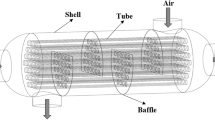Abstract
School of Mechanical and Industrial System Engineering, Dong-Eui University, Busan 614-714, Korea In a conventional shell-and-tube heat exchanger, fluid contacts with tubes flowing up and down in a shell, therefore there is a defect in the heat transfer with tubes due to the stagnation portions. Fins are attached to the tubes in order to increase heat transfer efficiency, but there exists a limit. Therefore, it is necessary to improve heat exchanger performance by changing the fluid flow in the shell. In this study, a highly efficient shell-and-tube heat exchanger with spiral baffle plates is simulated three-dimensionally using a commercial thermal-fluid analysis code, CFX4.2. In this type of heat exchanger, fluid contacts with tubes flowing rotationally in the shell. It could improve heat exchanger performance considerably because stagnation portions in the shell could be removed. It is proved that the shell-and-tube heat exchanger with spiral baffle plates is superior to the conventional heat exchanger in terms of heat transfer.
Similar content being viewed by others
Abbreviations
- A :
-
Area
- \(\overrightarrow B \) :
-
Body force
- H :
-
Total enthalpy
- h :
-
Static enthalpy
- k :
-
Thermal conductivity
- P :
-
Pressure
- Q :
-
Heat transfer rate
- T :
-
Temperature
- t :
-
Time
- \(\overrightarrow U \) :
-
Velocity vector
- U :
-
Velocity inx-direction, overall heat transfer coefficient
- V :
-
Velocity iny-direction
- W :
-
Velocity inx-direction
- ΔT lm :
-
Log mean temperature difference
- δ:
-
Kronecker delta
- μ:
-
Viscosity
- ρ:
-
Density
- σ:
-
Stress tensor
- ξ:
-
Bulk viscosity
- c :
-
Cold
- h :
-
Hot
- i :
-
Inlet
- o :
-
Outlet
- s :
-
Solid
- T :
-
Transpose
References
AEA Technology. 1997, CFX-4.2Manual, United Kingdom.
Gay, B., Mackley, N. V. and Jenkins, J. D., 1976, “Shell-Side Heat Transfer in Baffled Cylindrical Shell-and-Tube Heat Exchangers —An Electrochemical Mass Transfer Modeling Technique,”Int. J. of Heat and Mass Transfer, Vol. 19, pp. 995–1002.
Incropera, F. P. and DeWitt, D. P., 1996,Fundamentals of Heat and Mass Transfer, 4th ed., John Wiley & Sons Inc., New York.
Lee, K. S., Chung, J. Y. and Yoo, J. H., 1998, “Thermal and Flow Analysis for the Optimization of a Parallel Flow Heat Exchanger,”Transactions of KSME, Part B, Vol. 22, No. 2, pp. 229–239.
Lee, K. S. and Kim, W. S., 1999, “The Effects of Design and Operating Factors on the Frost Growth and Thermal Performance of a Flat Plate Fin-Tube Heat Exchanger Under the Frosting Condition,”KSME International Journal, Vol. 13, No. 12, pp. 973–981.
Lee, S. C, Cho, J. W. and Nam, S. C., 1997, “Effect of Baffle Parameters on Heat Transfer in Shell-and-Tube Heat Exchangers,”Transactions of KSME, Part B, Vol. 21, No. 1, pp. 185–194.
Lee, S. H., Nam, S. C. and Ban, T. G., 1998, “Performance of Heat Transfer and Pressure Drop in a Spirally Indented Tube,”KSME International Journal, Vol. 12, No. 5, pp. 917 -925.
Li, H. and Kottke, V., 1998a, “Effect of the Leakage on Pressure Drop and Local Heat Transfer in Shell-and-Tube Heat Exchanger for Staggered Tube Arrangement,”Int. J. of Heat and Mass Transfer, Vol. 41, No. 2, pp. 425- 433.
Li, H. and Kottke, V., 1998b, “Effect of Baffle Spacing on Pressure Drop and Local Heat Transfer in Shell-and-Tube Heat Exchanger for Staggered Tube Arrangement,”Int. J. of Heat and Mass Transfer, Vol. 41, No. 10, pp. 1303 -1311.
Patankar, S. V., 1980,Numerical Heat Transfer and Fluid Flow, Hemisphere Publishing Co., Washington.
Prithiviraj, M. and Andrews, M. J., 1998a, “Three Dimensional Numerical Simulation of Shell-and-Tube Heat Exchangers, Part I: Foundation and Fluid Mechanics,”Numerical Heat Transfer, Part A, Vol. 33, pp. 799–816.
Prithiviraj, M. and Andrews, M. J., 1998b, “Three Dimensional Numerical Simulation of Shell-and-Tube Heat Exchangers, Part II: Heat Transfer,”Numerical Heat Transfer, Part A, Vol. 33; pp. 817–828.
Shah, R. K. and Pignotti, A., 1997, “Influence of a Finite Number of Baffles on Shell-and-Tube Heat Exchanger Performance,”Heat Transfer Engineering, Vol. 18, No. 1, pp. 82–94.
Sparrow, E. M. and Reifschneider, L. G., 1986. “Effect of Interbaffle Spacing on Heat Transfer and Pressure Drop in a Shell-and-Tube Heat Exchanger,”Int. J. of Heat and Mass Transfer, Vol. 29, No. 11, pp. 1617–1628.
Van Doormaal, J. P. and Raithby, G. D., 1984, “Enhancements of the SIMPLE Method for Predicting Incompressible Fluid Flows,”Numerical Heat Transfer, Vol. 7, pp. 147–163.
Walker, G., 1990,Industrial Heat Exchangers A Basic Guide, 2nd ed., Hemisphere Publishing Co., New York.
Author information
Authors and Affiliations
Rights and permissions
About this article
Cite this article
Son, YS., Shin, JY. Performance of a shell-and-tube heat exchanger with spiral baffle plates. KSME International Journal 15, 1555–1562 (2001). https://doi.org/10.1007/BF03185746
Received:
Revised:
Issue Date:
DOI: https://doi.org/10.1007/BF03185746




